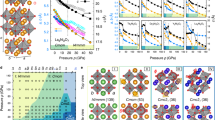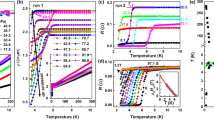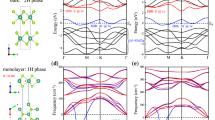Abstract
The recent discovery of superconductivity with a transition temperature (Tc) at 18 K in Kxpicene has extended the possibility of high-Tc superconductors in organic materials. Previous experience based on similar hydrocarbons, like alkali-metal doped phenanthrene, suggested that even higher transition temperatures might be achieved in alkali-metals or alkali-earth-metals doped such polycyclic-aromatic-hydrocarbons (PAHs), a large family of molecules composed of fused benzene rings. Here we report the discovery of high-Tc superconductivity at 33 K in K-doped 1,2:8,9-dibenzopentacene (C30H18). To our best knowledge, it is higher than any Tc reported previously for an organic superconductor under ambient pressure. This finding provides an indication that superconductivity at much higher temperature may be possible in such PAHs system and is worthy of further exploration.
Similar content being viewed by others
Introduction
The discovery of high-temperature superconductivity in iron pnictides has greatly renewed the interest in searching for other new high-Tc materials1,2,3,4. Organic metals and superconductors share many features with iron pnictides and cuprates - a quasi-two-dimensional band structure, the proximity to antiferromagnetism, unconventional superconductivity, etc. It becomes more and more evident that organic metals and superconductors serve as a fascinating field for materials science and solid state physics. More than one hundred molecular-based superconductors have been found since the discovery of first organic superconductor (TMTSF)2PF6 in 1979 [ref.5]. The highest transition temperature (Tc ≈ 13 K) was reported for the κ-(ET)2Cu[N(CN)2]Cl salt under applied pressure6. The discovery of Carbon-60 (C60, composed of fused benzene rings), has led to the discovery of a new subclass of organic superconductors, alkali-metal doped fullerides, A3C60 [ref.7,8,9], with the transition temperature up to 38 K under applied pressure9. In their chemical nature, all these compounds are either cation radical salts based on TTF-derivatives or anion radical salts based on the M(dmit)2 complexes and fullerene complexes. Their novel electronic properties are attributed to the delocalized π-electrons due to orbital overlap. Furthermore, superconductivity in graphite intercalation compounds (GICs) has been extensively studied for several decades, where Tc ranges from below 1 K for KC8 (Tc = 0.39 K) up to 11.5 K for CaC6 [ref.10,11]. Graphite is an extreme of the polycyclic condensed aromatic hydrocarbon, consisting of an infinite network of benzene rings. Thus, doping of such materials with π-electron networks might bring out novel physical properties, such as superconductivity. Indeed, very recently, Mitsuhashi et al. reported that superconductivity with Tc of 18 K could be induced by doping potassium into picene (C22H14)12, a hydrocarbon molecular with five benzene rings condensed in an armchair manner13,14,15,16. Here we report the superconductivity with transition temperature up to 33.1 K in potassium doped hydrocarbon with seven benzene rings, 1,2:8,9-dibenzopentacene. It is reasonable to expect that, through carrier doping, higher Tc superconductivity may be realized in other PAHs, a large family of molecules based on fused benzene rings.
Results
The temperature dependence of the magnetization measured in a field of 10 Oe for K3.17dibenzopentacene is given in Fig. 1. The zero-field-cooling (ZFC) and field-cooling (FC) susceptibility shows a sharp drop at around 28.2 K which also can be seen from the ac susceptibility as shown in the left inset in Fig. 1a. Such diamagnetic behavior is characteristic of superconductivity. The distinct magnetic signatures of ZFC and FC below the superconducting critical temperature originate from the screening supercurrent (ZFC regime) and the Meissner-Ochsenfeld effect of magnetic flux expulsion (FC regime). The diamagnetic signal onset temperature is described as superconductivity temperature Tconset. As seen from Fig. 1a, Tconset was defined to be 28.2 K for K3.17dibenzopentacene. The shielding volume fraction at 5 K is estimated to be 5.5% (assuming a density of 1.8 g/cm3), which is comparable to the value reported for superconducting Kxpicene12, Kxphenanthrene17 and is about the same as that initially reported for K-doped C60 and for Rb-doped C60 [ref.8,18], although following works have dramatically increased the superconducting fraction for alkaline-earth-metal doped phenanthrene19 and alkali-metal doped C60 [ref.20,21]. The small superconducting fraction may be due to the smaller sizes of the obtained crystallites than the London penetration depths12. Further investigations of the dependence of the superconducting fraction on temperature, initial composition and reaction time will undoubtedly lead to high yields of superconducting phase.
Magnetization data for K3.17dibenzopentacene.
(a) χ versus T plots for K3.17dibenzopentacene with Tconset = 28.2 K at H = 10 Oe (main panel). The left inset shows the ac susceptibility at H = 5 Oe and the right inset shows the molecular structure of dibenzopentacene; unfortunately, to our knowledge, no report on the crystal structure of 1,2:8,9-dibenzopentacene has been published. (b) χ versus T plots for the sample in the ZFC measurements under different magnetic field H. The solid lines indicate the determination of the transition temperature as described in the text. (c) The H versus Tc plot. (d) Field dependence of the magnetization isotherm for the sample measured at 4.5 K. The solid line gives the linear fit to the low field M(H) curve.
Figure 1b shows temperature dependence of measured χ for various applied fields H in the ZFC measurements. There was an obvious drop of χ at 23 K even at 1000 Oe, indicating that the superconducting phase is not completely destroyed at weak applied field. The fact that Tc is suppressed slowly by applying the magnetic fields indicates the observed superconductivity in this material is intrinsic. The corresponding upper critical field H versus Tc is plotted in Fig. 1c. Tc was determined through a linear extrapolation of the slopes before and after the point at which the sample began superconducting, as shown in Fig. 1b. At the present stage, it is difficult to determine the upper critical field Hc2(0) at 0 K from H-Tc curve. Figure 1d depicts the M(H) versus H plot at 4.5 K measured by sweeping the magnetic field at a constant rate of 10 Oe/sec, which indicates that K3.17dibenzopentacene is a type-II superconductor with a strong vortex pinning. In the Meissner state, M(H) curve is linear and the lower critical field Hc1 is defined as the field in which M(H) deviates from linearity. Here Hc1 was estimated to be 200 Oe at 4.5 K, which is higher than that of the potassium doped picene with Tc = 18 K [ref. 12] (Hc1 ∼100 Oe; however, the authors gave the value of 380 Oe determined from the minimum position of the M-H plot).
Superconductivity with higher temperature can also be observed for high K-content sample, K3.45dibenzopentacene. The onset temperature of diamagnetism is Tconset = 33.1 K as seen in ZFC experiment (see Fig. 2a), where the critical temperature is the highest to date among the organic superconductors under ambient pressure. The magnitude of the shielding signal at 25 K corresponds roughly to 3.2% of perfect diamagnetism. Additional features are seen at 20 K and 5 K, which might be ascribed to different superconducting phases with lower transition temperatures. One should note that the latter two characteristic temperatures are similar to the reported values for the superconducting Kxpicene and Kxphenanthrene12,17. It is reasonable to suspect that these two superconducting phases come from the breakdown of PAH chains during the reaction process. Interestingly, the Tc obtained for twice annealed sample of K3dibenzopentacene was 7.4 K, with superconducting shielding fraction of 3.6%, as shown in Fig. 2b. Similar phenomenon has been observed in Kxpicene12, where two superconducting phases (Tc = 7 or 18 K) were occasionally obtained under the same experimental conditions, but did not coexist with each other. Further efforts should be made to clarify this issue in the near future.
Temperature dependence of magnetization for K3.45dibenzopentacene and K3dibenzopentacene.
(a) χ versus T plots for superconducting K3.45dibenzopentacene at H = 10 Oe (main panel). The ZFC curve indicates the presence of three different superconducting phases. The left inset shows on an expanded scale, the region around Tc, revealing a critical temperature of 33.1 K. The right inset shows χ versus T plots for the sample K3.45dibenzopentacene in the ZFC measurements under different magnetic field H. It clearly shows that all the three superconducting transitions are suppressed slowly by applying the magnetic fields. (b) χ versus T plots for the twice annealed K3dibenzopentacene sample with TC = 7.4 K at H = 10 Oe.
Discussion
1,2:8,9-dibenzopentacene is a condensed aromatic hydrocarbon with both linear and angular fusion of the benzene rings, which can be viewed as two phenanthrene segments bridged through two –CH= group (see right inset of Fig. 1a). Regardless of the influence of the structural/geometric difference among picene, phenanthrene and dibenzopentacene (one should note that superconductivity with Tc up to 15 K was also observed for K-doped coronene, which is composed of six peri-fused benzene rings. It is still not clear whether the perfect W-shaped configurations of benzene rings are the key role to achieve superconductivity in doped PAHs13,14,15,16, although there is no superconductivity found for petancene, the isomer of picene12), it can be seen that with increasing the length of PAH chain, the superconducting transition temperature increases dramatically (see Fig. 3): Tc increases from 5 K for Kxphenanthrene17 with three benzene rings to 18 K for Kxpicene12 with five benzene rings and up to 33.1 K for Kxdibenzopentacene with seven benzene rings, which is in contrast to the theoretical predication22,23. In general, the dimensionless electron-phonon coupling constant λ = N(εF)V is directly related to V and N(εF). Here, the interaction matrix element V dominated by intramolecular vibrational modes is inversely proportional to the number of atoms in the molecule that donates π-electrons. Assuming a conventional Bardeen-Cooper-Schrieffer (BCS) mechanism with electron–phonon interaction and the same density of states N(εF) at the Fermi level, the doped phenanthrene should have the highest Tc in all the aromatic hydrocarbons22,23. However, in a molecular crystal, the crystal structure, molecular overlaps and phonon modes are important factors for determining the strength of pairing interaction.
Dependence of the superconducting transition temperature on the number of benzene rings.
Tc increases from 5 K for Kxphenanthrene with three benzene rings to 18 K for Kxpicene with five benzene rings and up to 33.1 K for Kxdibenzopentacene with seven benzene rings, shows linear relativity to the number of benzene rings.
Usually, increasing the length of the PAH chain would increase the extent of its interactions with neighboring chains, while the density of states at the Fermi level, is mainly dominated by intermolecular interactions. One can speculate that an increase in N(εF) overcomes any decreases in V on going from K3phenanthrene to K3dibenzopentacene. Further studies are needed, however, to shed more light on the microscopic aspects of pairing. It is believed that organic materials with higher superconducting transition temperature could be produced in the near future.
Methods
Samples were prepared by direct heating potassium metal with 1,2:8,9-dibenzopentacene in an evacuated tube at 300–350°C for 7–20 days. To improve the homogeneity of products, a second anneal is sometimes performed. An alternative method for sample synthesis was also developed. The starting materials were loaded into liquid ammonia solution and stirred for 6 hours. The resulting products were then dried under vacuum for several hours to remove the solvent and subsequently sealed in an evacuated tube and annealed at 250–300°C for 7–20 days. The latter synthetic route allows for a reduction of annealing temperature and improvement of homogeneity of the products, but it does not allow precise control of the potassium content of the resulting samples. All the obtained powder samples are uniform dark black in color, which is totally different from the red color of pure dibenzopentacene. Superconductivity was observed for the samples with compositions of the form Kxdibenzopentacene, for 3.0≤x≤3.5. It seems to be the fact that the superconducting shielding fraction could be improved by increasing the annealing temperature. Magnetization measurements have been performed in a commercial SQUID-VSM magnetometer (Quantum Design). For the zero-field-cooled (ZFC) magnetization measurements, the samples were first cooled down to 2.5 K in zero field, then the magnetic field was applied and the temperature raised to 50 K with 1 K/min. Thereafter, temperature was reduced to 2.5 K without changing the applied field. The field-cooled (FC) magnetization was then measured with increasing temperature. Hysteresis loop measurements were carried out at 4.5 K, after cooling in zero field from room temperature.
References
Kamihara, Y. et al. Iron-based layered superconductor La[O1-xF x]FeAs (x = 0.05–0.12) with Tc = 26 K. J. Am. Chem. Soc. 130, 3296–3297 (2008).
Chen, X. H. et al. Superconductivity at 43 K in SmFeAsO1-xFx . Nature 453, 761–762 (2008).
Ren, Z. A. et al. Superconductivity at 52 K in iron based F doped layered quaternary compound Pr[O1–xFx]FeAs. Mater. Res. Innovations 12, 105–106 (2008).
Chen, G. F. et al. Superconductivity at 41 K and its competition with spin-density-wave instability in layered CeO1-xFxFeAs. Phys. Rev. Lett. 100, 247002 (2008).
Jérome, D. et al. Superconductivity in a synthetic organic conductor (TMTSF)2PF6 . J. Phys. (France) Lett. 41, L-95-L-98 (1980).
Williams, J. M. et al. From semiconductor-semiconductor transition (42 K) to the highest-Tc organic superconductor, κ-(ET)2Cu[N(CN)2]Cl (Tc = 12.5 K). Inorg. Chem. 29, 3272–3274 (1990).
Hebard, A. F. et al. Superconductivity at 18 K in potassium-doped C60 . Nature 350, 600–601 (1991).
Stephens, P. W. et al. Structure of single-phase superconducting K3C60 . Nature 351, 632–634 (1991).
Ganin, A. Y. et al. Bulk superconductivity at 38K in a molecular system. Nature Mater. 7, 367–371 (2008).
Hannay, N. B. et al. Superconductivity in graphitic compounds. Phys. Rev. Lett. 14, 225–226 (1965).
Weller, T. E., Ellerby, M., Saxena, S. S., Smith, R. P. & Skipper, N. T. Superconductivity in the intercalated graphite compounds C6Yb and C6Ca. Nature Phys. 1, 39–41 (2005).
Mitsuhashi, R. et al. Superconductivity in alkali-metal-doped picene. Nature 464, 76–79 (2010).
Subedi, A. & Boeri, L. Vibrational spectrum and electron-phonon coupling of doped solid picene from first principles. Phys. Rev. B 84, 020508 (2011).
Casula, M. et al. Intercalant and intermolecular phonon assisted superconductivity in K-doped picene. Preprint at http://arxiv.org/abs/1106.1446v2 (2011)
De Andres, P. L. et al. Crystal structure and electronic states of tripotassium picene. Phys. Rev. B 83, 245113 (2011).
Kim, M. et al. Density functional calculations of electronic structure and magnetic properties of the hydrocarbon K3picene superconductor near the metal-insulator transition. Phys. Rev. B 83, 214510 (2011).
Wang, X. et al. Superconductivity at 5 K in alkali-metal-doped phenanthrene. Nature Commun. 2, 507–513 (2011).
Rosseinsky, M. J. et al. Superconductivity at 28 K in RbxC60 . Phys. Rev. Lett. 66, 2830–2832 (1991).
Wang, X. et al. Superconductivity in alkali-earth metals doped phenanthrene. Preprint at http://arxiv.org/abs/1110.5458 (2011)
Holczer, K. et al. Alkali-fulleride superconductors: synthesis, composition and diamagnetic shielding. Science 252, 1154–1157 (1991).
Kelty, S. P., Chen, C. C. & Lieber, C. M. Superconductivity at 30 K in cesium-doped C60 . Nature 352, 223–225 (1991).
Kato, T., Yoshizawa, K. & Hirao, K. Electron–phonon coupling in negatively charged acene- and phenanthrene-edge-type hydrocarbon crystals. J. Chem. Phys. 116, 3420 (2002).
Kato, T., Kambe, T. & Kubozono, Y. Strong intramolecular electron-phonon coupling in the negatively charged aromatic superconductor picene. Phys. Rev. Lett. 107, 077001 (2011).
Acknowledgements
The authors wish to thank Z. X. Zhao, L. L. Sun for their fruitful discussions and helpful comments. This work was supported by the Natural Science Foundation of China and by the Ministry of Science and Technology of China.
Author information
Authors and Affiliations
Contributions
M. Q. X. conceived the experiments, prepared the samples, carried out the magnetic susceptibility measurements and XRD measurements. Y. W., H. X. Y., X. L. D. provided assistance with the magnetic susceptibility measurements and XRD measurements. D. M. W., J. B. H. and F. W. L. provided assistance with sample synthesis. T. B. C. initiated the project. G. F. C. initiated the project, conceived and supervised the experiments, analyzed the data and wrote the paper.
Ethics declarations
Competing interests
The authors declare no competing financial interests.
Rights and permissions
This work is licensed under a Creative Commons Attribution-NonCommercial-ShareALike 3.0 Unported License. To view a copy of this license, visit http://creativecommons.org/licenses/by-nc-sa/3.0/
About this article
Cite this article
Xue, M., Cao, T., Wang, D. et al. Superconductivity above 30 K in alkali-metal-doped hydrocarbon. Sci Rep 2, 389 (2012). https://doi.org/10.1038/srep00389
Received:
Accepted:
Published:
DOI: https://doi.org/10.1038/srep00389
This article is cited by
-
Structure, charge transfer, and superconductivity of M-doped phenanthrene (M = Al, Ga, and In): A comparative study of K-doped cases
Science China Physics, Mechanics & Astronomy (2019)
-
π-electron S = ½ quantum spin-liquid state in an ionic polyaromatic hydrocarbon
Nature Chemistry (2017)
-
Redox-controlled potassium intercalation into two polyaromatic hydrocarbon solids
Nature Chemistry (2017)
-
Synthesis successes
Nature Chemistry (2017)
-
Combined experimental and computational study of high-pressure behavior of triphenylene
Scientific Reports (2016)
Comments
By submitting a comment you agree to abide by our Terms and Community Guidelines. If you find something abusive or that does not comply with our terms or guidelines please flag it as inappropriate.






